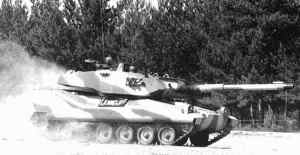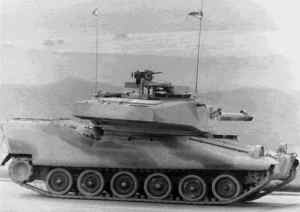| Designation: | VFM 5 |
 |
|---|---|---|
| Manufacturer: | Vickers Defence Systems Ltd. | |
| Product type: | Armoured Vehicles | |
| Name: | Light tank |
In October 1985 at the Association of the United States Army (AUSA) Exhibition, FMC showed the Close Combat Vehicle Light (CCV L). This sophisticated light tank with a crew of three and an autoloader was originally designed to meet an anticipated US Army requirement for an Armored Gun System.
In 1985 Vickers Defence Systems and FMC teamed up to build a variant of the CCV L more suitable for export markets. The prototype of the VFM 5 Battle Tank was completed in May 1986 and shown for the first time at the 1986 British Army Equipment Exhibition. As of early 1993, the Vickers/FMC VFM 5 battle tank was still at the prototype stage and had yet to be demonstrated outside the UK.
The VFM 5 battle tank is fully airportable in the US C-130 and C-141 transport aircraft.
The hull of the VFM 5 is of welded aluminium armour with applique high-hardness steel plates on the front and sides.
The VFM 5 is protected to the same levels as many other first-generation battle tanks. Its layout is conventional with the driver's compartment at the front, the fighting compartment in the centre and the engine compartment at the rear.
The driver sits in the centre of the hull at the front. The rear-hinged hatch has five periscopes to give excellent visibility to the front and sides. The centre periscope can be replaced by a passive periscope for night driving. The driver has an adjustable sprung seat with a folding backrest to allow free access to the turret. Stowage for 11 rounds of main armament ammunition is provided on each side of the driver's position.
The turret of the VFM 5 is of welded aluminium armour wih applique high-hardness steel plates all around. Protection is similar to that given by the hull. The turret is mounted on a high-accuracy low-friction bearing ring which is tilted down at the front by 3º. This forward tilt allows 10º of main armament depression at the front, while permitting limited depression over the rear and reducing the turret height. This means the VFM 5 can be made to meet the stringent size, weight and height requirements for the Low Altitude Parachute Extraction System (LAPES), should it be required.
Main armament is a 105 mm Low Recoil Force gun which is fitted with an integral muzzle brake to further reduce trunnion pull. The turret is designed to accept any of the available 105 mm guns manufactured by Royal Ordnance, Rheinmetall or Watervleit Arsenal.
The 105 mm gun of the VFM 5 is fitted with a Vickers rigid thermal sleeve that reduces gun barrel bend and provides a number of advantages over other types of sleeve. According to Vickers, their rigid thermal sleeve is resilient to damage, unaffected by rain, ensures uniform heat distribution around the barrel, reduces the thermal signature of the barrel and may also be transferred to the replacement barrel.
There are 41 rounds of main armament ammunition carried, 22 (11 either side of the driver) stowed in the front of the hull and 19 in the fighting compartment. All ammunition is stowed below the turret ring.
A 7.62 mm L8 machine gun, mounted coaxially with the main armament, is fed from a box containing 200 rounds of ready use ammunition; a further 2400 rounds are carried in close proximity to the weapon.
A 12.7 mm or 7.62 mm machine gun is externally mounted over the loader's station. In total, 100 rounds of 12.7 mm or 200 rounds of 7.62 mm are available for ready use. If the 12.7 mm machine gun is fitted, 500 rounds for it are carried internally.
A bank of six grenade dischargers is fitted on each side of the turret. Smoke or fragmentation grenades can be fired electrically by the commander.
For the weapon control, Marconi Radar and Control Systems has developed an integrated system incorporating gun stabilisation and computerised fire-control.
The gun control system gives two-axis stabilisation with full-duplex control for the gunner and commander. Power traverse is through 360º and power elevation from -10 to +20º.
The electromechanical system eliminates the risk of hydraulic oil leaking or catching fire in battle.
The computerised fire-control system linked to the laser rangefinder gives a high probability of a first round hit at all battle ranges.
The gunner's main combat sight is a NANOQUEST ×10 telescopic sight bolted rigidly to the gun rotor. It incorporates a laser rangefinder and muzzle reference system. This muzzle reference system allows the gunner to check his gun/sight alignment while under armour protection. The system can be used at all angles of elevation or depression.
For wide-angle observation a NANOQUEST periscope is linked to main armament and fitted in front of the gunner. An optional thermal imaging system can be fitted. For this the gunner will have a monitor to the right of his GS10 sight, linked to the commander's sight, allowing him to engage targets at night and in poor visibility.
The commander has a Pilkington PE Raven II day/night sight, five periscopes for all-round observation and a rear-opening single piece hatch cover. The commander's sight has magnifications of ×1 and ×8 as well as an image intensification night channel.
The loader has a rear-opening single piece hatch cover and a single periscope AFV No 30 Mk 1 with 360º rotation for observation.
The VFM 5 has torsion bar suspension and six dual rubber-tyred road wheels on each side of the vehicle. The torsion bars give an upward suspension travel of 25.4 cm jounce and 10.2 cm rebound. A linear hydraulic shock absorber is fitted at five road wheel stations providing high cross-country mobility and stable firing platform characteristics.
The tracks are 38 cm wide and are of the double-pin type with detachable, large area ground pads.
The VFM 5 is powered by a General Motors, Detroit Diesel Model 6V-92 TA six-cylinder diesel developing 552 bhp at 2300 rpm. This two-cycle engine is turbocharged and fitted with an after-cooler.
The engine is coupled to a General Electric HMPT-500-3 automatic transmission which is the latest upgraded model of that installed in the M2 IFV and M3 CFV. This hydromechanical transmission gives continuously variable gear ratios in three forward and one reverse speed ranges. Responsive hydromechanical steering and hydrostatic dynamic braking are incorporated into the gearbox. Mechanically actuated service and parking brakes are also incorporated into the
gearbox casing.
A water radiator and oil cooler provide cooling for the power pack. Air is drawn through the radiator into the engine compartment then expelled by a fan in the hull roof. A heavy-duty air cleaner protects the engine in dusty or sandy environments. A 300 A generator provides electrical power. Four batteries are fitted in the right side of the engine compartment and two more in the turret. Access to these batteries for daily checks is via a hatch in the hull or turret roof.
The rear hull ramp folds down for access to the engine compartment. The engine can be slid out onto the ramp by the crew without special tools. Access covers are provided so that maintenance checks can be easily carried out by the crew. The power pack is protected from fire by a firewire connected to an automatic extinguisher system. Hand extinguishers are provided for the crew. The VFM 5 may also be fitted with a crew compartment fire suppression system.
|
||||||||||||||||||||||||||||||||||||||||||||||||||||||||||||||
|
||||||||||||
 |
 |
 |